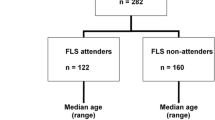Abstract
OBJECTIVE: To evaluate the pattern of osteoporosis evaluation and management in postmenopausal women who present with low-impact (minimal trauma) fracture.
DESIGN: Retrospective chart review of patients admitted with a fracture in the absence of trauma or bone disease. Telephone follow-up survey was conducted at 12 months after discharge to collect information on physician visits, pharmacological therapies for osteoporosis, functional status, and subsequent fractures.
PATIENTS/PARTICIPANTS: Postmenopausal women admitted to a hospital in St. Paul, Minnesota between June 1996 and December 1997 for low-impact fractures were identified. Low-impact fracture was defined as a fracture occurring spontaneously or from a fall no greater than standing height. Retrospective review of 301 patient medical records was conducted to obtain data on pre-admission risk factors for osteoporosis and/or fracture, and osteoporosis-related evaluation and management during the course of hospitalization. Follow-up 1 year after the incident fracture was obtained on 227 patients.
MEASUREMENTS AND MAIN RESULTS: Two hundred twenty-seven women were included in the study. Osteoporosis was documented in the medical record in 26% (59/227) of the patients at hospital discharge. Within 12 months of hospital discharge, 9.6% (22/227) had a bone mineral density test, and 26.4% (60/227) were prescribed osteoporosis treatment. Of those who were prescribed osteoporosis treatment, 86.6% (52/60) remained on therapy for 1 year. Nineteen women suffered an additional fracture. Compared to women without a prior fracture, women with at least 1 fracture prior to admission were more likely to have osteoporosis diagnosed and to receive osteoporosis-related medications.
CONCLUSION: Despite guidelines that recommend osteoporosis evaluation in adults experiencing a low-trauma fracture, we report that postmenopausal women hospitalized for low-impact fracture were not sufficiently evaluated or treated for osteoporosis during or after their hospital stay. There are substantial opportunities for improvement of care in this high-risk population to prevent subsequent fractures.
Similar content being viewed by others
References
Riggs BL, Melton LJ III. The worldwide problem of osteoporosis: insights afforded by epidemiology. Bone. 1995;7(suppl 5):505–11.
National Osteoporosis Foundation. Osteoporosis Fast Facts. Available at: http://www.nof.org/osteoporosis/stats.htm. Accessed September 6, 2000.
Scheiber LB, Torregrosa L. Evaluation and treatment of postmenopausal osteoporosis. Semin Arthritis Rheum. 1998;27:245–61.
Chrischilles E, Shireman T, Wallace R. Costs and health effects of osteoporotic fractures. Bone. 1994;15:377–86.
Barret-Connor E. The economic and human costs of osteoporotic fracture. Am J Med. 1995;98:3–8.
Ray NF, Chan JK, Thamer M, Melton LJ III. Medical expenditures for the treatment of osteoporotic fractures in the United States in 1995: report from the National Osteoporosis Foundation. J Bone Miner Res. 1997;12:24–35.
Cooper C. The crippling consequences of fractures and their impact on quality of life. Am J Med. 1997;103(2A):12S-17S; discussion 17S–19S.
National Osteoporosis Foundation. Osteoporosis. Review of the evidence for prevention, diagnosis, and treatment and cost-effectiveness analysis. Osteoporosis Int. 1998;8:1S-88S.
Melton LJ III, Thamer M, Ray NF, et al. Fractures attributable to osteoporosis: report for the National Osteoporosis Foundation. J Bone Miner Res. 1997;12:16–23.
Freedman KB, Kaplan FS, Bilker WB, Strom BL, Lowe RA. Treatment of osteoporosis: are physicians missing an opportunity? J Bone Joint Surg Am. 2000;82:1063–70.
Cuddihy M, Gabriel SE, Crowson CS, et al. Osteoporosis intervention following distal forearm fractures. Arch Intern Med. 2002;162:421–6.
Lydick E, Cook K, Turpin J, Melton M, Stine R, Byrnes C. Development and validation of a simple questionnaire to facilitate identification of women likely to have low bone density. Am J Manag Care. 1998;4:37–48.
Morbidity and Mortality Weekly Report. Osteoporosis among estrogen-deficient women—United States, 1988–1994. November 20, 1998;Vol 47; No 45. Available at: http://www.cdc.gov/mmwr/preview/index98.html. Accessed September 12, 2000.
Gallagher TC, Geling O, Comite F. Missed opportunities for prevention of osteoporotic fracture. Arch Intern Med. 2002;162:450–6.
Melton LJ III, Atkinson EJ, Cooper C, O’Fallon WM, Riggs BL. Vertebral fractures predict subsequent fractures. Osteoporos Int. 1999;10:214–21.
Black DM, Arden NK, Palerno L, Pearson J, Cummings SR. Prevalent vertebral deformities predict hip fractures and new vertebral deformities but not wrist fractures. Study of Osteoporotic Fractures Research Group. J Bone Miner Res. 1999;14:821–8.
Togerson DJ, Campbell MK, Thomas RE, Reid DM. Prediction for perimenopausal fractures by bone mineral density and other risk factors. J Bone Miner Res. 1996;11:293–7.
Guccione AA, Felson DT, Anderson JJ, et al. The effects of specific medical conditions on the functional limitations of elders in the Framingham Study. Am J Public Health. 1994;84:351–8.
Klotzbuecher CM, Ross PD, Landsman PB, Abbott TA III, Berger M. Patients with prior fractures have an increased risk of future fractures: a summary of the literature and statistical synthesis. J Bone Miner Res. 2000;15:721–7.
Simonelli C, Killeen K, Mehle S, Swanson L. Barriers to osteoporosis identification and treatment among primary care physicians and orthopedic surgeons. Mayo Clinic Proc. 2002;77:334–8.
Author information
Authors and Affiliations
Corresponding author
Additional information
Portions of these study results were presented in a poster format at the National Osteoporosis Foundation/International Osteoporosis Foundation meeting, June 2001, Chicago, Ill.
Dr. Simonelli has received research funds and is a consultant to Merck and Company, Eli Lilly, Procter and Gamble, and Novartis. Merck and Company provided statistical support and assistance in manuscript preparation but did not participate in study design or collection of data.
Rights and permissions
About this article
Cite this article
Simonelli, C., Chen, YT., Morancey, J. et al. Evaluation and management of osteoporosis following hospitalization for low-impact fracture. J GEN INTERN MED 18, 17–22 (2003). https://doi.org/10.1046/j.1525-1497.2003.20387.x
Issue Date:
DOI: https://doi.org/10.1046/j.1525-1497.2003.20387.x




